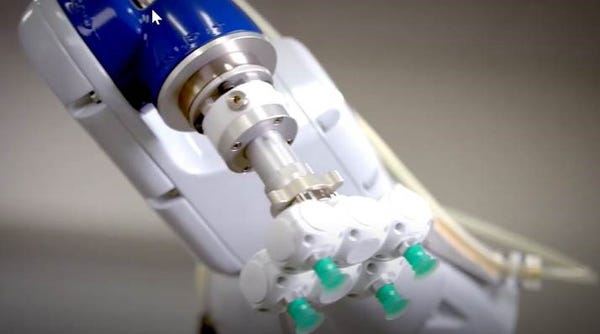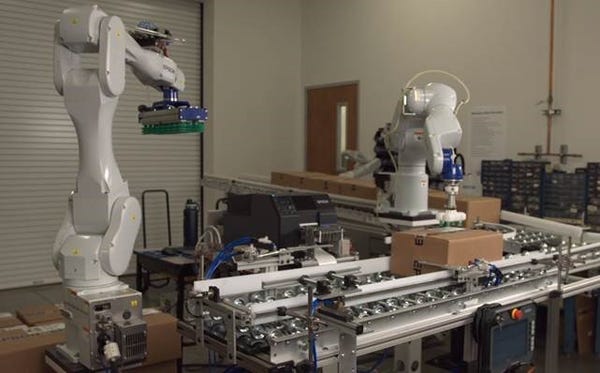The packaging operation on a manufacturing line is often the most fully automated stage. Robots have taken over packaging across many industries, from CPG to medtech.
November 18, 2020

The packaging operation is detailed, complex, but repeatable. While it’s not an easy operation to get right, the benefits of a fully automated packaging effort are immense. The result is efficiency, speed, and quality.
We caught up with Aaron Donlon, product manager at Epson America who works in the company’s Factory Automation Robotics group. Donlon’s expertise in detailed packaging operations comes from his Bachelor’s and Master’s in mechanical engineering as well as his time working for an equipment OEM and in the consumer packaged good industry working on both the factory floor as a plant engineer.
Donlon walked us through what it takes to create an effective packaging operation.
DN: What is involved in creating an effective robot automation application/system for packaging?
Aaron Donlon: It all begins with filling out your request-for-proposal with as much detail as you can possibly provide. The most critical inputs are speeds required, sizes of the product, and what pack pattern configurations are required. Providing samples is also important. To determine the actual weight of the product in addition to the packaging. For example, a gallon of milk in a glass container is much heavier than a gallon of milk in a plastic one. In addition, by providing samples of the product the automation engineer can determine what kind of end-of-arm tooling can be used to pick the product. Will a simple vacuum tool be enough to handle the product, or is something more complex and heavier necessary?

The end-of-arm tool along with the product is necessary for determining the inertia the robot will experience. Just like maximum payload, every robot has a maximum amount of inertia each joint can resist. Once this is determined the robot kinematics will govern how fast the robot can accelerate and decelerate, ultimately affecting the speed. An automation engineer may swap in different robots in a simulation tool to determine the best robot to handle the speeds of the application. An enabling technology is the use of 3D printed end-of-arm tools. These can be custom designed with composite materials eliminating extra weight over traditional manufacturing methods.
DN: How important is it to determine the pattern of the packing?
Aaron Donlon: The pack patterns will be critical. Is the product simply picked and placed into the package or will they need to be rotated or nested prior to loading? The more complicated the load pattern, the more likely it is that additional steps in the process will be necessary. Many case packers use robots to load directly into the case, but if the packing pattern requires the product to be rotated 90 degrees prior to loading that must be taken into account.
How to mount the robot and controller in a packaging machine is also a key decision that will affect the overall size of a packaging machine. Ceiling mount typically provides the greatest reach for a robot, to pick and place the product, but the frame must be designed stiff enough to reduce the reactive load of the robot. The placement of the electrical controller is critical as well. It is a compromise between allowing access for maintenance personnel and having enough room around it to dissipate heat and keep it away from sources of contamination.
DN: What constitutes an effective robot application? Speed? Ease of use? Agility? Flexibility? Fast change-overs?
Aaron Donlon: An effective robot application is one that contributes to satisfying the needs of the customer’s business. If the use of robotics helps to resolve a real customer business issue, they will continue to invest in the future.
Every business and every engineer has a list of needs and wants. Most customers are concerned with not only the capability to run this product at this rate but also delivery time, enhanced safety, ease of use, sanitation, controls architecture….etc. In the packaging space though we do know changeovers are much more frequent than in the past, and the very fast pace of change does require the equipment to be very flexible. Ease of use will continue to be a requirement to allow for successful operation on the plant floor. Remote access and troubleshooting from OEMs will continue to expand as customers want to reduce their costs and the time it takes for a service rep to be on site.
Speed to market, with a focus on delivery, may be key to their business to launch a product before a shelf reset or begin a contract with a new customer sooner. Conversely, some folks may be focused on changeover and flexibility. If you are a copacker you would be better focused on those.
DN: How important is simulation to the manufacturing process these days?
Aaron Donlon: What we are seeing robotics do for the packaging industry is freeing up some time for the engineers tasked with building these systems to allow them to create and simulate the rest of the system knowing that the motion control is designed and simulated. This extra time not spent designing a gantry or XYZ plains can be spent focusing on ways to better collate and load product into a given container with end-of-arm tool designs.
We also see some merging of new technologies, even the larger end-of-arm tools companies like Schmalz and Piab have embraced 3D printing of end-of-arm tools that in packaging can easily translate to different formats the robots can run.

DN: What is involved in integrating a robotic packaging operation? Aligning the software of disparate equipment?
Aaron Donlon: Integrating a robotic packaging operation faces the same challenges as any packaging automation solution. A packaging machine can be made up of motors, sensors, solenoid valves, air cylinders, laser coders, heaters, scanners, robots, printers, dust collectors….and on. For a packaging machine, there is the main controller for the system taking in inputs from all of those devices.
In some instances, it may be the robot itself that is the main controller, or a PLC is very common in the packaging space. Having a standard Fieldbus protocol for communication has made the integration of all these signals from different suppliers much easier than it was in the past. For example, at Epson Robots we support multiple Fieldbus protocols with Ethernet/IP being a very popular option. Taking another step forward, to make our robots easier to integrate with the popular Allen Bradley PLC devices we created Add on Instructions software. This software allows the programmer to stay in their native ladder logic environment and program the robot functions just like they would turn on a motor or switch in their program.
DN: Is part of the process bringing incompatible equipment (matching the right robot with the right conveyors, etc.), or has equipment become flexible enough that compatibility is not a profound issue?
Aaron Donlon: A robot is part of a packaging system application. It can be a very big part and be the muscle and the brain of the operation, or many times it is the muscle on a machine and is merely told to move things around. But a robot does need supporting equipment around it to handle the incoming packages, to convey the product into it, and all the other supporting functions. As much care and thought must go into the product and packaging material handling as programming the moves of the robot. Even with a robot, a machine will perform poorly if the cases all crash into each other or get crushed due to backpressure before they are loaded.
A common enough operation in packaging is to pick single units randomly oriented on a conveyor and place them into a pattern. That pattern is then picked and loaded into the final carton or case. It is not uncommon to use vision with a backlight under the belt to find the product. What is critical on this conveyor is that the speed of the belt is known, the product does not shift around, and that a clear image can be taken of the product.
Experienced builders will ensure that the encoders do not slip, the belt transitions are smooth, the splices are flat, the belt material is resistant to dust buildup, transfer from the product is minimal, and can be cleaned easily.
DN: What new technology is having an impact on packaging operations?
Aaron Donlon: There are some emerging technologies like laser-guided 3D scanning that are getting better every year and the prices keep coming down. The benefit of this new technology, once it matures, is that you eliminate the requirements of a vision system and also get the height of the product, allowing the robot to compensate for the height variety of the incoming product.
For end-of-arm tooling, there is a great range of products that can be customized but are still right off the shelf. The design of end-of-arm tools used to be very time consuming and expensive but is very turnkey now. Another gauge I have on the automation space is that you can literally buy a robot pedestal and safety barrier off McMaster Carr right now. It is a great time in automation where the pieces are much less custom and come at a commercial price point to make automation affordable so that small and medium-sized businesses can see the benefits.
DN: How important is it to match the operation with the right HMI and analytics?
Aaron Donlon: An HMI that operators and mechanics can interface with is critical for the long-term performance of any piece of automation. Error handling and fault messaging must be developed to enable a short mean time to recover after a machine error. What this looks like in practice is, after a machine fault, the operator will scan the HMI, may or may not jog the machine, and then safely interact with the machine and get it started back up right the first time. A machine with a poor HMI will take several tries to get going again and may even require a call to maintenance.
Security and change-logs are important to ensure that program changes are managed and accounted for. It is critical to have different levels of access to features on the machine. There are running adjustments that may need to be made by operators, but there are also key parameters that should only be changed by an experienced maintenance or site engineer. Even with these permissions, it is critical to see what changes were made to isolate a problem during troubleshooting. After finding a component that has or was failing, it is critical to returning the machine to the centerline.
Access to analytical data is critical to make sure that machine performance does not degrade over time. Good data is a key ingredient to increasing machine performance, for machine stoppages can be targeted for reduction, a known method to increase machine uptime.
Rob Spiegel has covered automation and control for 19 years, 17 of them for Design News. Other topics he has covered include supply chain technology, alternative energy, and cybersecurity. For 10 years, he was the owner and publisher of the food magazine Chile Pepper.
About the Author(s)
You May Also Like





